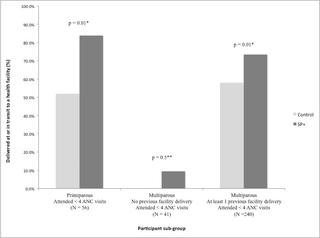PLOS ONE ( IF 2.9 ) Pub Date : 2018-06-18 , DOI: 10.1371/journal.pone.0199400 Kristy Hackett , Curtis Lafleur , Peter Nyella , Ophira Ginsburg , Wendy Lou , Daniel Sellen

|
Background
About half of births in rural Tanzania are assisted by skilled providers. Point-of-care mobile phone applications hold promise in boosting job support for community health workers aiming to ensure safe motherhood through increased facility delivery awareness, access and uptake. We conducted a controlled comparison to evaluate a smartphone-based application designed to assist community health workers with data collection, education delivery, gestational danger sign identification, and referrals.
Methods
Community health workers in 32 randomly selected villages were cluster-randomized to training on either smartphone (intervention) or paper-based (control) protocols for use during household visits with pregnant women. The primary outcome measure was postnatal report of delivery location by 572 women randomly selected to participate in a survey conducted by home visit. A mixed-effects model was used to account for clustering of subjects and other measured factors influencing facility delivery.
Findings
The smartphone intervention was associated with significantly higher facility delivery: 74% of mothers in intervention areas delivered at or in transit to a health facility, versus 63% in control areas. The odds of facility delivery among women counseled by smartphone-assisted health workers were double the odds among women living in control villages (OR, 1.96; CI, 1.21–3.19; adjusted analyses). Women in intervention areas were more likely to receive two or more visits from a community health worker during pregnancy than women in the control group (72% vs. 60%; chi-square = 6.9; p < 0.01). Previous facility delivery, uptake of antenatal care, and distance to the nearest facility were also strong independent predictors of facility delivery.
Interpretation
Community health worker use of smartphones increased facility delivery, likely through increased frequency of prenatal home visits. Smartphone-based job aids may enhance community health worker support and effectiveness as one component of intervention packages targeting safe motherhood.
Trial registration
NCT03161184.
中文翻译:

智能手机辅助的产前家访对妇女使用设施的影响:坦桑尼亚农村地区的一项集群随机试验的结果
背景
坦桑尼亚农村地区约有一半的分娩由熟练的提供者协助。即时医疗移动电话应用有望为社区卫生工作者增加工作支持,旨在通过提高设施交付意识,访问和吸收来确保安全孕产。我们进行了对照比较,评估了基于智能手机的应用程序,该应用程序旨在帮助社区卫生工作者进行数据收集,教育交付,妊娠危险标志识别和转诊。
方法
对32个随机选择的村庄的社区卫生工作者进行了集群随机化,以接受智能手机(干预)或纸质(控制)协议的培训,以便在与孕妇进行家访时使用。主要结果指标是随机选择参加家庭访问调查的572名妇女的分娩后产后报告。混合效果模型用于说明受试者的聚类以及影响设施交付的其他测量因素。
发现
智能手机的干预与更高的设施交付率相关:74%的母亲在干预区在医疗机构或医疗机构中交付,而控制区的这一比例为63%。由智能手机辅助的卫生工作者建议的女性接受设施交付的几率是生活在控制村庄中女性的几倍(OR为1.96; CI为1.21-3.19;调整后的分析结果)。与对照组的妇女相比,干预地区的妇女在怀孕期间更有可能接受社区卫生工作者的两次或两次以上探视(72%比60%;卡方= 6.9; p <0.01)。先前的医疗机构交付,接受产前护理以及到最近的医疗机构的距离也是医疗机构交付的强有力的独立预测因素。
解释
社区卫生工作者使用智能手机增加了设施的交付,这可能是通过增加产前家访的频率来实现的。基于智能手机的工作辅助工具可以增强社区卫生工作者的支持和有效性,将其作为针对安全孕产的一揽子干预措施的组成部分。
试用注册
NCT03161184。











































 京公网安备 11010802027423号
京公网安备 11010802027423号